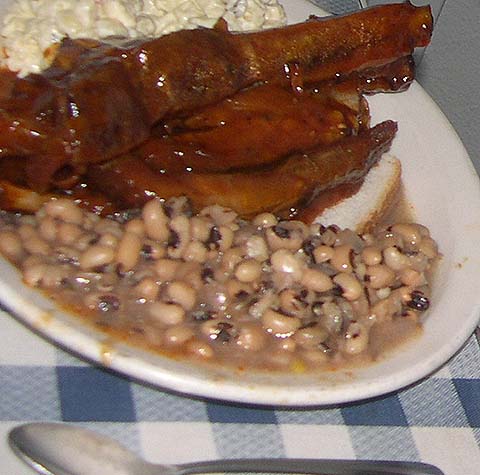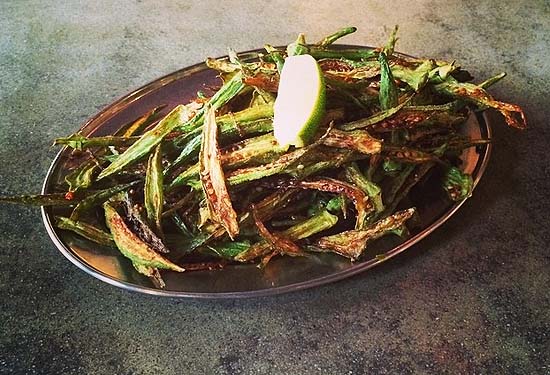SOULFUL DELICACIES: TRACING THE ORIGINS OF SOUL FOOD

SOULFUL DELICACIES: TRACING THE ORIGINS OF SOUL FOOD
Soul Food refers to the quintessential African-American cuisine. Gaining popularity in the 1960s, the origins of this cuisine can be traced back to a dark period of history when slavery was at its peak. The European enslavers, along with other atrocities that they perpetrated upon their slaves, even withheld their food privileges. Making do only with the leftovers of crops and meat, the slaves were forced to prepare their food with meager ingredients.
Out of this dark phase came the idea of soul food which is now widely coveted. The distinguishing feature of soul food is the concept of “sharing” associated with it. Imagining the olden days when the slaves had to make do with the scanty supply of food, one can see how sharing must have been the only way for survival.

Ribs and Black Eyed Peas Source
The dietary staples among the enslaved Africans in terms of crops were mainly rice and corn, left over from the plantation. Corn being one of the staples was used to make most of the dishes from cornbread and grits to various liquors such as whiskey and moonshine, using the technology of Nixtamalization. The process of nixtamalization involves soaking and cooking corn in alkaline solutions such as limewater. This ensures various health benefits as it maximizes the nutritional benefits of corn and also enhances the flavor and taste of the corn. The vegetables they had at their disposal were the tops of turnips, beets and dandelions along with green vegetables like kale, collards and others like mustard and pokeweed.
Meat was provided to them from the discarded parts such as pig’s feet, ox tail, pig ears, ham cocks, pork jowls, tripe and skin. The slaves, however, developed recipes from these leftovers by adding onions, thyme, garlic and other such herbs to enhance the flavor, and many of these recipes are still popular across cultures. For instance, Chitterlings, a commonly known dish in Africa, which dates back thousands of years, is prepared by frying the small intestines of hogs.
Another source of meat for the natives was Venison, a white tailed deer found in profusion in certain parts of the continent. Apart from the meat, other organs like liver, brain, intestines were also used for cooking. Other prominently consumed meats were obtained from raccoons, turtles, rabbits and squirrels.
Most of the soul food recipes have been passed on across generations orally, as it was forbidden to the enslaved African-Americans to learn to read and write. As a matter of fact, the first documentation of the soul food recipes was done in 1881 with the publication of the first soul cook book by Abby Fisher called “What Mrs. Fisher Knows about Southern Cooking”.
Though widely popular, one critique attributed to this cuisine is that it is considered to be very unhealthy. High in starch, fat, sodium and cholesterol, people run the risk of developing diabetes, high blood pressure, clogged arteries leading to cardiac concerns. However, if we were to look at the historical roots of this cuisine, a lot of ingredients were managed with a lot of difficulty to prepare a decent meal. For instance, finding it too expensive to afford shortening every time to cook, they would instead pour the already used liquefied cooking grease into a container and cool it. After it re-solidified they would use it again for cooking their next meal.
There have been many renditions of soul food developed by modern cooks in an attempt to make it healthier. However, food critics reject this practice as they feel it destroys the authenticity of the cuisine. It has also been pointed out that the food though rich in calories, also has a high nutritional content as it furnishes essential vitamins and minerals to the body. It also provides ‘phytonutrients’ known to prevent ovarian and breast cancer.
The greasy and scrumptious dishes adapted by the modern restaurants are manifestations of the original recipes made more visually appealing and palatable. Among the commonly served dishes in soul food restaurants are fried chicken, ribs, turkey wings, meatloaf, pork chops and beef sausages along with another popular mac n’ cheese.
Here are a few soul food recipes for you to try at home. Prepare these delicacies and share them with your friends and family.
1. FRIED OKRA

Fried Okra Source
Ingredients
1 pound fresh okra, cut into 1 inch pieces
1 large green tomato, diced
1 onion chopped
1 clove garlic, minced
1 jalapeno pepper, seeds removes and sliced
2 eggs, beaten
1/4 teaspoon salt
1/4 teaspoon black pepper
1/2 cup milk
1 cup cornmeal
1/4 cup vegetable oil
Method
In one bowl, combine okra with tomato, garlic and jalapeno. In a separate bowl combine eggs, milk, salt and pepper. Now pour this mixture onto the vegetables. Slowly, add cornmeal to this mix soaking all the vegetables and making the mixture even and gooey. In saucepan heat oil and as soon as oil is hot spoon the mixture evenly into the pan. Simmer down the heat and let the mixture fry for 10-15 minutes until its underside turns golden-brown. Invert the fried mixture onto a plate and carefully place the un-browned side onto the heated pan again. Cook this mixture, without covering, for another 10-15 minutes and then place the cooked okra onto paper napkins to soak the excess oil. Serve the crispy okra hot with a side of jalapenos for added flavor.
2. CHITTERLINGS

Chitterlings Source
Ingredients
20 lbs. chitterlings, cleaned and cut up 1 to 2 inch lengths
1 to 2 quarts of water
1 garlic clove, chopped
1 onion, chopped
4 bell peppers chopped
2 teaspoons salt
2 teaspoons pepper
1/2 cup apple cider vinegar
cayenne pepper to taste optional
Method
Firstly wash and clean the chitterlings thoroughly getting rid of the fat and debris. Soak in salted water for an hour to cleanse it entirely and then rinse in clean water thrice. In a large stock pot, fill water to the brim so that it covers the chitterlings entirely. Add garlic, thyme, salt and pepper for added flavor and cook for 3-4 hours. You may serve them boiled or fried.
3. SMOTHERED PIG EARS

Pig Ears Source
Ingredients
4 lbs. Pig Ears (about 8 lg. ears)
1 cup chopped green onions
1 1/2 cups chopped yellow onions
3 toes (i.e. cloves) of garlic
1/4 cup vegetable oil
1 Tbs. flour
1/4 tsp. cayenne pepper
1/4 tsp. black pepper
1 tsp. granulated garlic
1 tsp. salt (to taste)
Method
Wash the pig ears thoroughly and burn off any hair on them beforehand. Fill a large pot with water enough to cover the pig ears and boil them for 10 minutes. Once boiled, rinse off the water and add clean water again to cover them. Cook on medium heat and add cayenne, black pepper, salt and granulated garlic. In a separate skillet heat oil until hot, add flour and stir continuously. After it turns into a golden-caramel color, add yellow and green onions to it. Stir till the onions have wilted and then add to the pot with pig ears, cover the pot and wait for the mix to come to a boil. After it has reached a boiling point, reduce to the heat to low and let it cook for 2 hours until the pig ears become tender. Add more spices or herbs if necessary. Serve this dish with rice. You could also pair it up with corn bread, sweet peas and candied yams.
Have a news story, an interesting write-up or simply a suggestion? Write to us at
info@oneworldnews.com







